Enhancing Intelligence: From the Group to the Individual
Abstract
:1. Introduction
2. Behavior, Cognition, and the Brain
3. Cognition and Brain Networks: Summary, Discussion, and Integration of Previously Published Findings
3.1. Framework
3.2. Behavior/Cognition
3.3. The Brain
3.3.1. VBM, TBM and SBM
3.3.2. Structural Connectivity
3.4. Integration and Conclusions
- (1)
- Are brain changes related to cognitive performance across training sessions?
- (2)
- Are brain changes related to changes in near (working memory capacity) and far (fluid reasoning ability) transfer psychological factors measured before and after training?
4. The Future: From the Group to the Individual
- Acquire raw data in the scanner applying minimal preprocessing (realignment, field inhomogeneity correction, grand mean scaling, and so forth).
- Warp volumetrically subcortical areas and register the cortex to a surface template using multimodal surface matching.
- Select whole-brain or ROIs analyses and project data into a common space.
- Model preprocessed data and compute multidimensional statistics for an individual.
- Use individual statistics for predicting individual measures, such as general cognitive ability level or group classification (e.g., training versus control).
- Compare full and null models to obtain the unique predictive value of the imaging statistic.
5. Conclusions: Personalized Training
Acknowledgments
Author Contributions
Conflicts of Interest
References
- Colom, R.; Román, F.J.; Abad, F.J.; Shih, P.C.; Privado, J.; Froufe, M.; Escorial, S.; Martínez, K.; Burgaleta, M.; Quiroga, M.A.; et al. Adaptive n-back training does not improve fluid intelligence at the construct level: Gains on individual tests suggest that training may enhance visuospatial processing. Intelligence 2013, 41, 712–727. [Google Scholar] [CrossRef]
- Colom, R.; Martínez, K.; Burgaleta, M.; Román, F.J.; García-García, D.; Gunter, J.L.; Hua, X.; Jaeggi, S.M.; Thompson, P.M. Gray matter volumetric changes with a challenging adaptive cognitive training program based on the dual n-back task. Pers. Individ. Dif. 2016, 98, 127–132. [Google Scholar] [CrossRef]
- Colom, R.; Hua, X.; Martínez, K.; Burgaleta, M.; Román, F.J.; Gunter, J.L.; Carmona, S.; Jaeggi, S.M.; Thompson, P.M. Brain structural changes following adaptive cognitive training assessed by Tensor-Based Morphometry. Neuropsychologia 2016, 91, 77–85. [Google Scholar] [CrossRef] [PubMed]
- Román, F.J.; Lewis, L.B.; Chen, C.-H.; Karama, S.; Burgaleta, M.; Martínez, K.; Lepage, C.; Jaeggi, S.M.; Evans, A.C.; Kremen, W.S.; et al. Gray matter responsiveness to adaptive working memory training: A Surface-Based Morphometry Study. Brain Struct. Funct. 2016, 221, 4369–4382. [Google Scholar] [CrossRef] [PubMed]
- Román, F.J.; Iturria-Medina, Y.; Martínez, K.; Karama, S.; Burgaleta, M.; Jaeggi, S.M.; Barbey, A.K.; Evans, A.C.; Colom, R. Enhanced structural connectivity within a brain network supporting working memory related processes and engagement after cognitive training. Neurobiol. Learn. Mem. 2017, 141, 33–43. [Google Scholar] [CrossRef] [PubMed]
- Flynn, J.R. What Is Intelligence? Beyond the Flynn Effect; Cambridge University Press: Cambridge, UK, 2007; ISBN 9780521880077. [Google Scholar]
- Flynn, J.R. Are We Getting Smarter? Rising IQ in the Twenty-First Century; Cambridge University Press: Cambridge, UK, 2016; ISBN 9781107028098. [Google Scholar]
- Buschkuehl, M.; Jaeggi, S.M. Improving intelligence: A literature review. Swiss Med. Wkly. 2010, 140, 266–272. [Google Scholar] [PubMed]
- Jaeggi, S.M.; Studer-Luethi, B.; Buschkuehl, M.; Su, Y.-F.; Jonides, J.; Perrig, W.J. The relationship between n-back performance and matrix reasoning: Implications for training and transfer. Intelligence 2010, 38, 625–635. [Google Scholar] [CrossRef]
- Klingberg, T. Training and plasticity of working memory. Trends Cogn. Sci. 2010, 14, 317–324. [Google Scholar] [CrossRef] [PubMed]
- Morrison, A.B.; Chein, J.M. Does working memory training work? The promise and challenges of enhancing cognition by training working memory. Psychon. Bull. Rev. 2011, 18, 46–60. [Google Scholar] [CrossRef] [PubMed]
- Haier, R.J. The Neuroscience of Intelligence; Cambridge University Press: Cambridge, UK, 2017; ISBN 978-1107461437. [Google Scholar]
- Jaeggi, S.M.; Buschkuehl, M.; Jonides, J.; Perrig, W.J. Improving fluid intelligence with training on working memory. PNAS 2008, 105, 6829–6833. [Google Scholar] [CrossRef] [PubMed]
- Gottfredson, L. A g Theorist on Why Kovacs and Conway’s Process Overlap Theory Amplifies, Not Opposes, g Theory. Psychol. Inq. 2016, 27, 210–217. [Google Scholar] [CrossRef]
- Abad, F.J.; Quiroga, M.A.; Colom, R. Intelligence assessment. In Reference Module in Neuroscience and Biobehavioral Psychology; Stein, J., Dunbar, R., Eds.; Elsevier: Amsterdam, The Netherlands, 2017; ISBN 9780128093245. [Google Scholar]
- McGrew, K.S. CHC theory and the human cognitive abilities project: Standing on the shoulders of the giants of psychometric intelligence research. Intelligence 2009, 37, 1–10. [Google Scholar] [CrossRef]
- Colom, R. Advances on intelligence research: What should be expected in the XXI Century (Questions & Answers). Span. J. Psychol. 2016, 19. [Google Scholar] [CrossRef]
- Detterman, D.K.; Petersen, E.; Frey, M.C. Process Overlap and System Theory: A simulation on, comment on, and Integration of Kovacs and Conway. Psychol. Inq. 2016, 27, 200–204. [Google Scholar] [CrossRef]
- Kovacs, K.; Conway, A.R.A. Process Overlap Theory: A Unified Account of the General Factor of Intelligence. Psychol. Inq. 2016, 27, 151–177. [Google Scholar] [CrossRef]
- Valenzuela, M.J.; Breakspear, M.; Sachdev, P. Complex mental activity and the aging brain: Molecular, cellular and cortical network mechanisms. Brain Res. Rev. 2007, 56, 198–213. [Google Scholar] [CrossRef] [PubMed]
- Cracchiolo, J.R.; Mori, T.; Nazian, S.J.; Tan, J.; Potter, H.; Arendash, G.W. Enhanced cognitive activity—Over and above social or physical activity—Is required to protect Alzheimer’s mice against cognitive impairment, reduce Abeta deposition, and increase synaptic immunoreactivity. Neurobiol. Learn. Mem. 2007, 88, 277–294. [Google Scholar] [CrossRef] [PubMed]
- Chapman, S.B.; Aslan, S.; Spence, J.S.; Hart, J.J., Jr.; Bartz, E.K.; Didehbani, N.; Keebler, M.W.; Gardner, C.M.; Strain, J.F.; DeFina, L.F.; et al. Neural Mechanisms of Brain Plasticity with Complex Cognitive Training in Healthy Seniors. Cereb. Cortex 2015, 25, 396–405. [Google Scholar] [CrossRef] [PubMed]
- Lövdén, M.; Bäckman, L.; Linderberger, U.; Schaefer, S.; Schmiedek, F. A Theoretical Framework for the Study of Adult Cognitive Plasticity. Psychol. Bull. 2010, 136, 659–676. [Google Scholar] [CrossRef] [PubMed]
- Hunt, E.B. Human Intelligence; Cambridge University Press: Cambridge, UK, 2011; ISBN 978-0521707817. [Google Scholar]
- Adolphs, R. The unsolved problems of neuroscience. Trends Cogn. Sci. 2015, 19, 173–175. [Google Scholar] [CrossRef] [PubMed]
- Protzko, J. The environment in raising early intelligence: A meta-analysis of the fadeout effect. Intelligence 2015, 53, 202–210. [Google Scholar] [CrossRef]
- Schwaighofer, M.; Fischer, F.; Bühner, M. Does Working Memory Training Transfer? A Meta-Analysis Including Training Conditions as Moderators. Educ. Psychol. 2015, 50, 138–166. [Google Scholar] [CrossRef]
- Soveri, A.; Antfolk, J.; Karlsson, L.; Salo, B.; Laine, M. Working memory training revisited: A multi-level meta-analysis of n-back training studies. Psychol. Bull. Rev. 2017, 24, 1077–1096. [Google Scholar] [CrossRef] [PubMed]
- Colom, R.; Thompson, P.M. Understanding Human Intelligence by Imaging the Brain. In Handbook of Individual Differences; Chamorro-Premuzic, T., von Stumm, S., Furnham, A., Eds.; Wiley-Blackwell: London, UK, 2011; ISBN 978-1444334388. [Google Scholar]
- Colom, R.; Haier, R.J.; Head, K.; Álvarez-Linera, J.; Quiroga, M.A.; Shih, P.C.; Jung, R.E. Gray matter correlates of fluid, crystallized, and spatial intelligence: Testing the P-FIT model. Intelligence 2009, 37, 124–135. [Google Scholar] [CrossRef]
- Haier, R.J.; Colom, R.; Schroeder, D.; Condon, C.; Tang, C.; Eaves, E.; Head, K. Gray matter and intelligence factors: Is there a neuro-g? Intelligence 2009, 37, 136–144. [Google Scholar] [CrossRef]
- Button, K.S.; Ioannidis, J.P.A.; Mokrysz, C.; Nosek, B.A.; Flint, J.; Robinson, E.S.J.; Munafò, M.R. Power failure: Why small sample size undermines the reliability of neuroscience. Nat. Rev. Neurosci. 2013, 14, 365–376. [Google Scholar] [CrossRef] [PubMed]
- Au, J.; Buschkuehl, M.; Duncan, G.J.; Jaeggi, S. There is no convincing evidence that working memory training is NOT effective: A reply to Melby-Lervag and Hulme (2015). Psychol. Bull. Rev. 2016, 23, 331–337. [Google Scholar] [CrossRef] [PubMed]
- Jaeggi, S.M.; Buschkuehl, M.; Perrig, W.J.; Meier, B. The concurrent validity of the N-back task as a working memory measure. Memory 2010, 18, 394–412. [Google Scholar] [CrossRef] [PubMed]
- Martínez, K.; Burgaleta, M.; Román, F.J.; Escorial, S.; Shih, P.C.; Quiroga, M.A.; Colom, R. Can fluid intelligence be reduced to “simple” short-term storage? Intelligence 2011, 39, 473–480. [Google Scholar] [CrossRef]
- Carpenter, P.A.; Just, M.A.; Shell, P. What one intelligence test measures: A theoretical account of the processing in the Raven Progressive Matrices Test. Psychol. Rev. 1990, 97, 404–431. [Google Scholar] [CrossRef] [PubMed]
- Colom, R.; Rebollo, I.; Abad, F.J.; Shih, P.C. Complex span tasks, simple span tasks, and cognitive abilities: A re-analysis of key studies. Mem. Cogn. 2006, 34, 158–171. [Google Scholar] [CrossRef]
- Halford, G.S.; Cowan, N.; Andrews, G. Separating cognitive capacity from knowledge: A new hypothesis. Trends Cogn. Sci. 2007, 11, 236–242. [Google Scholar] [CrossRef] [PubMed]
- Melby-Lervåg, M.; Hulme, C. Is working memory training effective? A meta-analytic review. Dev. Psychol. 2013, 49, 270–291. [Google Scholar] [CrossRef] [PubMed]
- Stephenson, C.L.; Halpern, D.F. Improved matrix reasoning is limited to training on tasks with a visuospatial component. Intelligence 2013, 41, 341–357. [Google Scholar] [CrossRef]
- Thomas, C.; Baker, C.I. Teaching an adult brain new tricks: A critical review of evidence for training-dependent structural plasticity in humans. Neuroimage 2013, 73, 225–236. [Google Scholar] [CrossRef] [PubMed]
- Thomas, C.; Baker, C.I. On evidence, biases and confounding factors: Response to commentaries. Neuroimage 2013, 73, 265–267. [Google Scholar] [CrossRef] [PubMed]
- Chen, C.H.; Gutierrez, E.D.; Thompson, W.; Panizzon, M.S.; Jernigan, T.L.; Eyler, L.T.; Fennema-Notestine, C.; Jak, A.J.; Neale, M.C.; Franz, C.E.; et al. Hierarchical genetic organization of human cortical surface area. Science 2012, 335, 1634–1636. [Google Scholar] [CrossRef] [PubMed]
- Chen, C.H.; Fiecas, M.; Gutierrez, E.D.; Panizzon, M.S.; Eyler, L.T.; Vuoksimaa, E.; Thompson, W.K.; Fennema-Notestine, C.; Hagler, D.J., Jr.; Jernigan, T.J.; et al. Genetic topography of brain morphology. Proc. Natl. Acad. Sci. USA 2013, 110, 17089–17094. [Google Scholar] [CrossRef] [PubMed]
- Jung, R.E.; Haier, R.J. The Parieto-Frontal Integration Theory (P-FIT) of intelligence: Converging neuroimaging evidence. Behav. Brain Sci. 2007, 30, 135–154. [Google Scholar] [CrossRef] [PubMed]
- Pineda-Pardo, J.A.; Martínez, K.; Román, F.J.; Colom, R. Structural Efficiency within a Parieto-Frontal Network and Cognitive Differences. Intelligence 2016, 54, 105–116. [Google Scholar] [CrossRef]
- Shors, T.J. The adult brain makes new neurons, and effortful learning keeps them alive. Curr. Dir. Psychol. Sci. 2014, 23, 311–318. [Google Scholar] [CrossRef]
- Ilg, R.; Wohlschläger, A.M.; Gaser, C.; Liebau, Y.; Dauner, R.; Wöller, A.; Zimmer, C.; Zihl, J.; Mühlau, M. Gray matter increase induced by practice correlates with task-specific activation: A combined functional and morphometric magnetic resonance imaging study. J. Neurosci. 2008, 28, 4210–4215. [Google Scholar] [CrossRef] [PubMed]
- Haier, R.J.; Karama, S.; Leyba, L.; Jung, R.E. MRI assessment of cortical thickness and functional activity changes in adolescent girls following three months of practice on a visual-spatial task. BMC Res. Notes 2009, 2, 174. [Google Scholar] [CrossRef] [PubMed]
- Kwok, V.; Niu, Z.; Kay, P.; Zhou, K.; Mo, L.; Jin, Z.; So, K.-F.; Tan, L.H. Learning new color names produces rapid increase in gray matter in the intact adult human cortex. PNAS 2011, 108, 6686–6688. [Google Scholar] [CrossRef] [PubMed]
- Mackey, A.P.; Whitaker, K.J.; Bunge, S.A. Experience-dependent plasticity in white matter microstructure: Reasoning training alters structural connectivity. Front. Neuroanat. 2012, 6, 32. [Google Scholar] [CrossRef] [PubMed]
- Yeo, T.; Krienen, F.M.; Eickhoff, S.B.; Yaakub, S.N.; Fox, P.T.; Buckner, R.L.; Asplund, C.L.; Chee, M.W. Functional Specialization and Flexibility in Human Association Cortex. Cereb. Cortex 2015, 25, 3654–3672. [Google Scholar] [CrossRef] [PubMed]
- Anguera, J.A.; Boccanfuso, J.; Rintoul, J.L.; Al-Hashimi, O.; Faraji, F.; Janowich, J.; Kong, E.; Larraburo, Y.; Rolle, C.; Johnston, E.; et al. Video game training enhances cognitive control in older adults. Nature 2013, 501, 97–101. [Google Scholar] [CrossRef] [PubMed]
- Subramaniam, K.; Luks, T.L.; Fisher, M.; Simpson, G.V.; Nagarajan, S.; Vinogradov, S. Computerized cognitive training restores neural activity within the reality monitoring network in schizophrenia. Neuron 2012, 73, 842–853. [Google Scholar] [CrossRef] [PubMed]
- McFarland, D.J. How neuroscience can inform the study of individual differences in cognitive abilities. Rev. Neurosci. 2017, 28, 343–362. [Google Scholar] [CrossRef] [PubMed]
- Colom, R.; Chuderski, A.; Santarnecchi, E. Bridge over Troubled Water: Commenting on Kovacs & Conway’s Process Overlap Theory. Psychol. Inq. 2016, 27, 181–189. [Google Scholar] [CrossRef]
- Johnson, W.; Bouchard, T.J. The structure of human intelligence: It is verbal, perceptual, and image rotation (VPR), not fluid and crystallized. Intelligence 2005, 33, 393–416. [Google Scholar] [CrossRef]
- Paivio, A. Imagery and Verbal Processes; Psychology Press: New York, NY, USA, 1971; ISBN 978-0030851735. [Google Scholar]
- Paivio, A. Mental Representations: A Dual Coding Approach; Oxford University Press: New York, NY, USA, 1986; ISBN 978-0195066661. [Google Scholar]
- Paivio, A. Intelligence, dual coding theory, and the brain. Intelligence 2014, 47, 141–158. [Google Scholar] [CrossRef]
- Johnson, W.; Jung, R.E.; Colom, R.; Haier, R.J. Cognitive Abilities Independent of IQ Correlate with Regional Brain Structure. Intelligence 2008, 36, 18–28. [Google Scholar] [CrossRef]
- Dubois, J.; Adolphs, R. Building a science of individual differences from fMRI. Trends Cogn. Sci. 2016, 20, 425–443. [Google Scholar] [CrossRef] [PubMed]
- Finn, E.S.; Shen, X.; Scheninost, D.; Rosenberg, M.D.; Huang, J.; Chun, M.M.; Papademetris, X.; Constable, R.T. Functional connectome fingerprinting: Identifying individuals using patterns of brain connectivity. Nat. Neurosci. 2015, 18, 1664–1671. [Google Scholar] [CrossRef] [PubMed]
- Clark, V.P.; Coffman, B.A.; Mayer, A.R.; Weisend, M.P.; Lane, T.D.R.; Calhoun, V.D.; Raybourn, E.M.; Garcia, C.M.; Wassermann, E.M. TDCS guided using fMRI significantly accelerates learning to identify concealed objects. Neuroimage 2012, 59, 117–128. [Google Scholar] [CrossRef] [PubMed]
- Santarnecchi, E.; Rossi, S. Advances in the Neuroscience of Intelligence: From Brain Connectivity to Brain Perturbation. Span. J. Psychol. 2016, 19. [Google Scholar] [CrossRef] [PubMed]
- Santarnecchi, E.; Rossi, S.; Rossi, A. The smarter, the stronger: Intelligence level correlates with brain resilience to systematic insults. Cortex 2015, 64, 293–309. [Google Scholar] [CrossRef] [PubMed]
- Santarnecchi, E.; Muller, T.; Rossi, S.; Sarkar, A.; Polizzotto, N.R.; Rossi, A.; Kadosh, R.C. Individual differences and specificity of prefrontal gamma frequency tACS on fluid intelligence capabilities. Cortex 2016, 75, 33–43. [Google Scholar] [CrossRef] [PubMed]
- Kirschner, P.A.; Sweller, J.; Clark, R.E. Why minimal guidance during instruction does not work: An analysis of the failure of constructivist, discovery, problem-based experiential, and inquiry-based teaching. Educ. Psychol. 2006, 41, 75–86. [Google Scholar] [CrossRef]
- Snow, R.E. Aptitude-treatment interaction as a framework for research on individual differences in learning. In Learning and Individual Differences: Advances in Theory and Research; Ackerman, P.A., Sternberg, R.J., Glaser, R., Eds.; Freeman: New York, NY, USA, 1989; pp. 13–59. ISBN 978-0716719854. [Google Scholar]
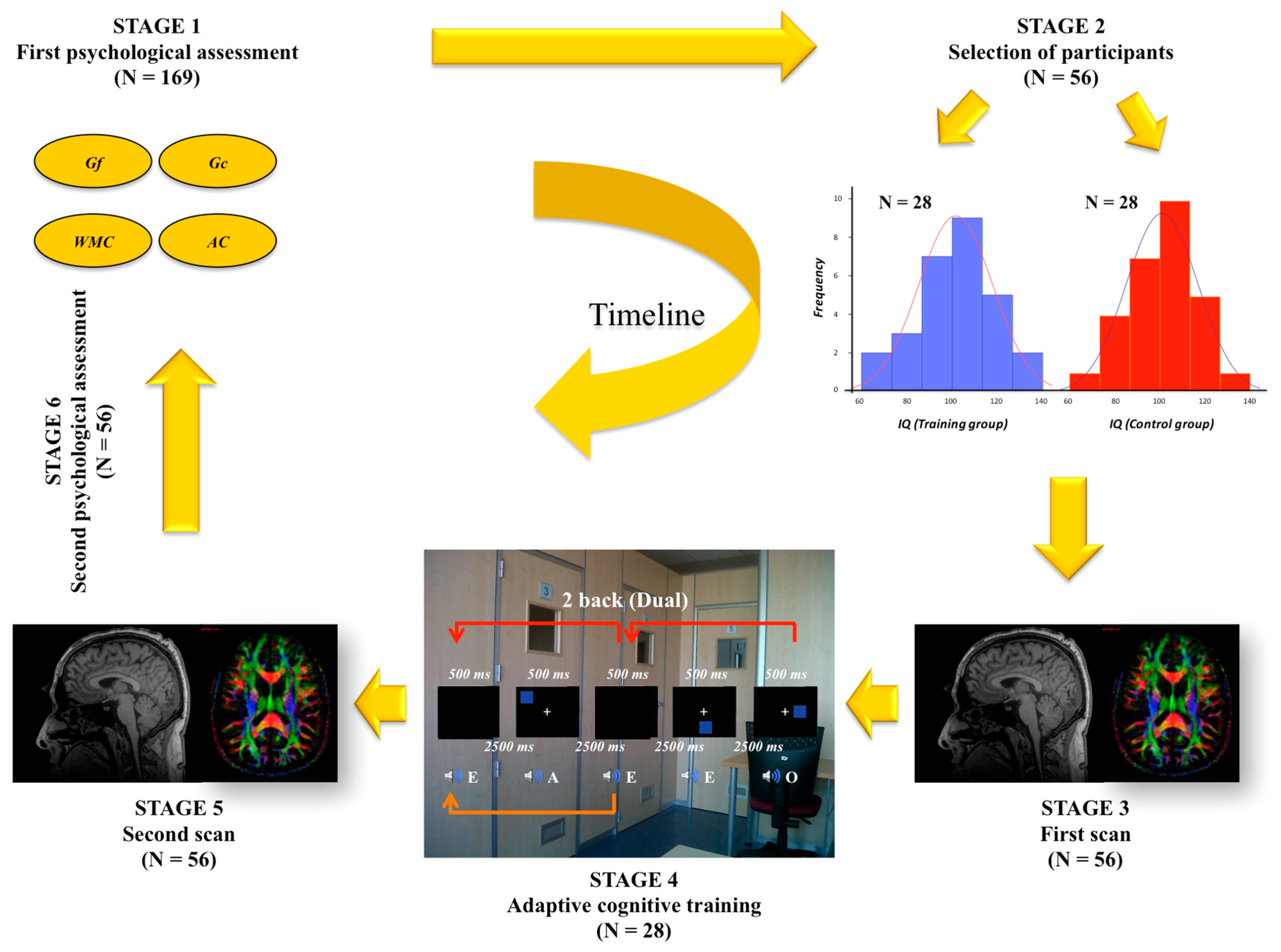

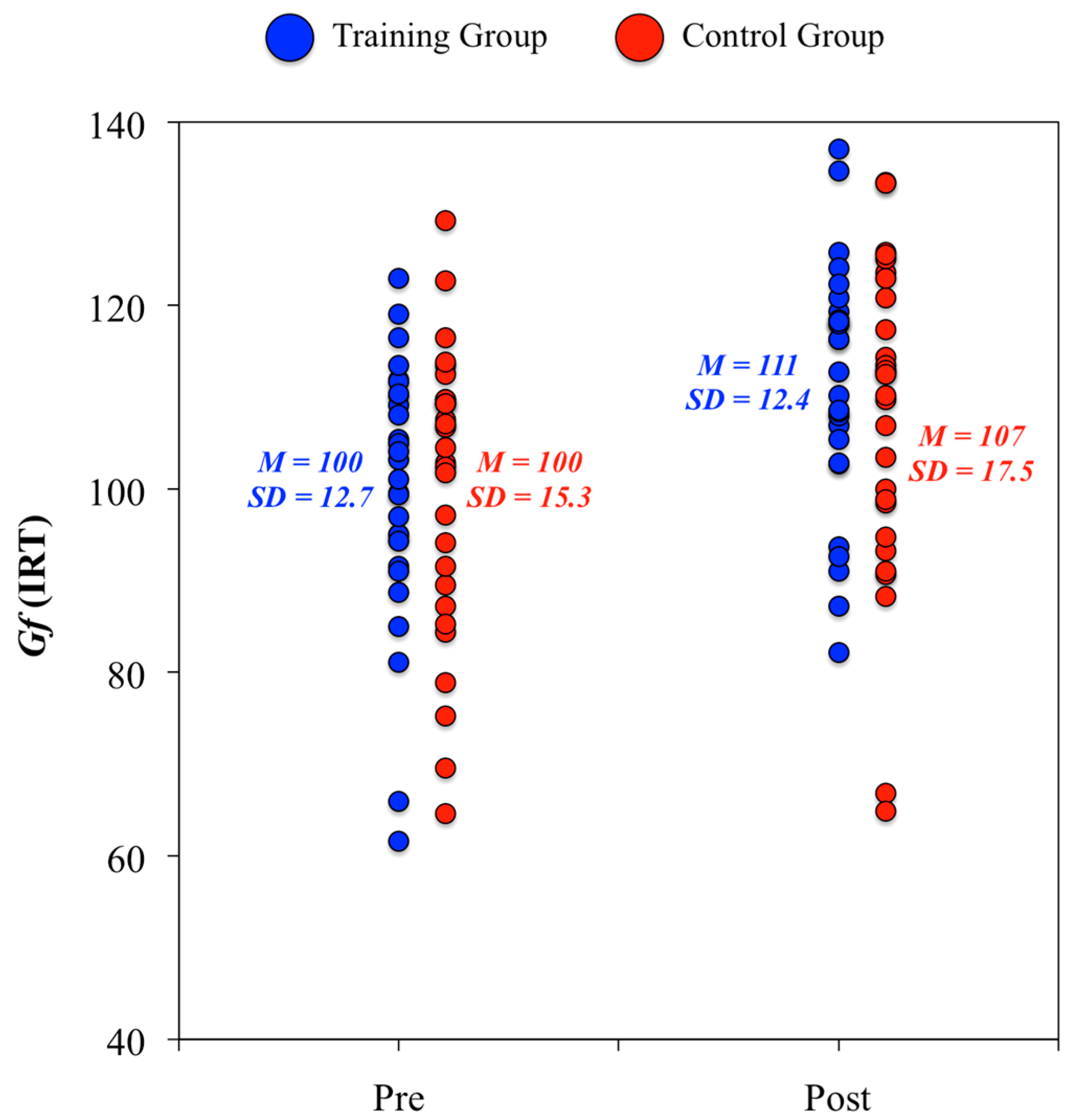
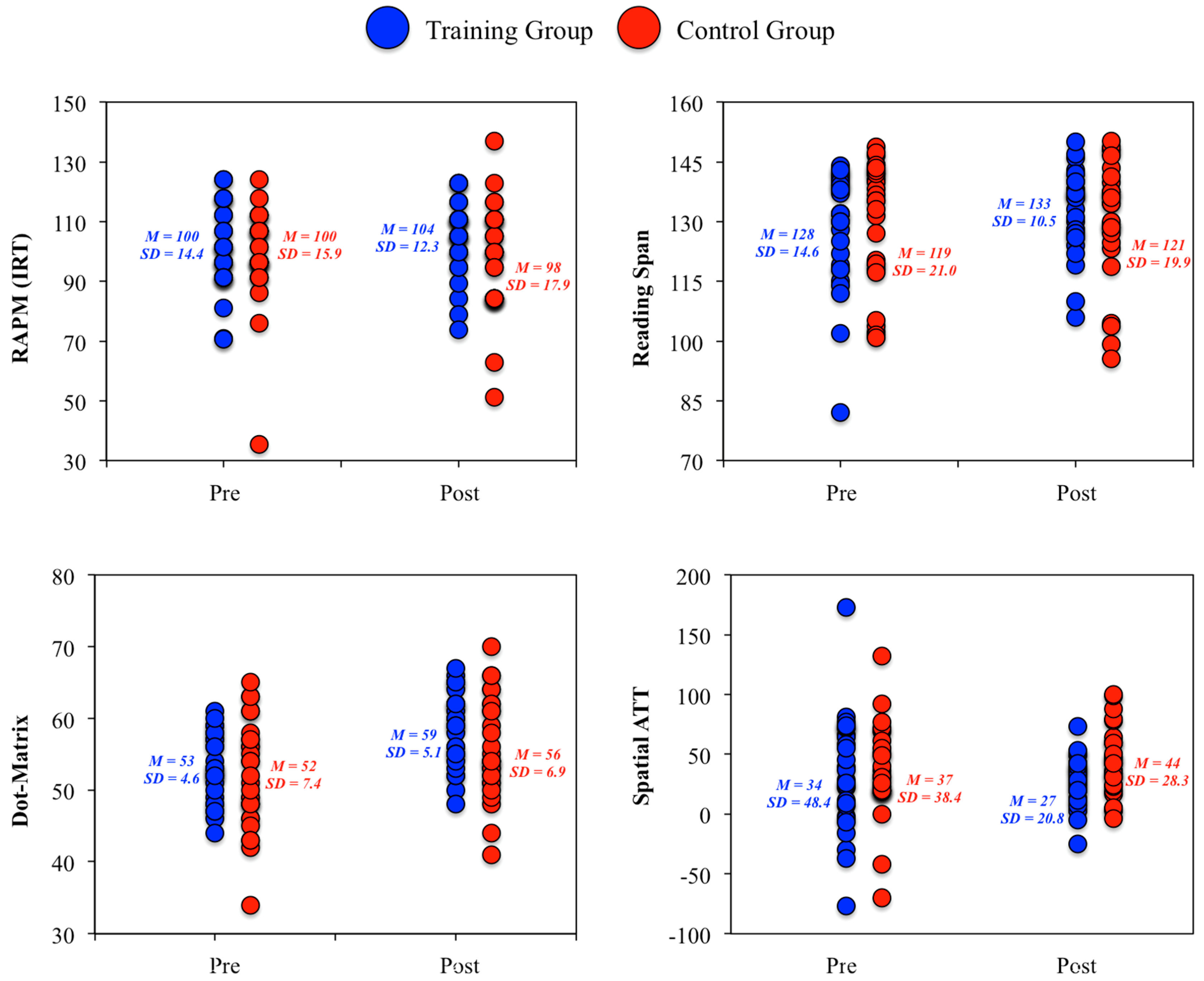
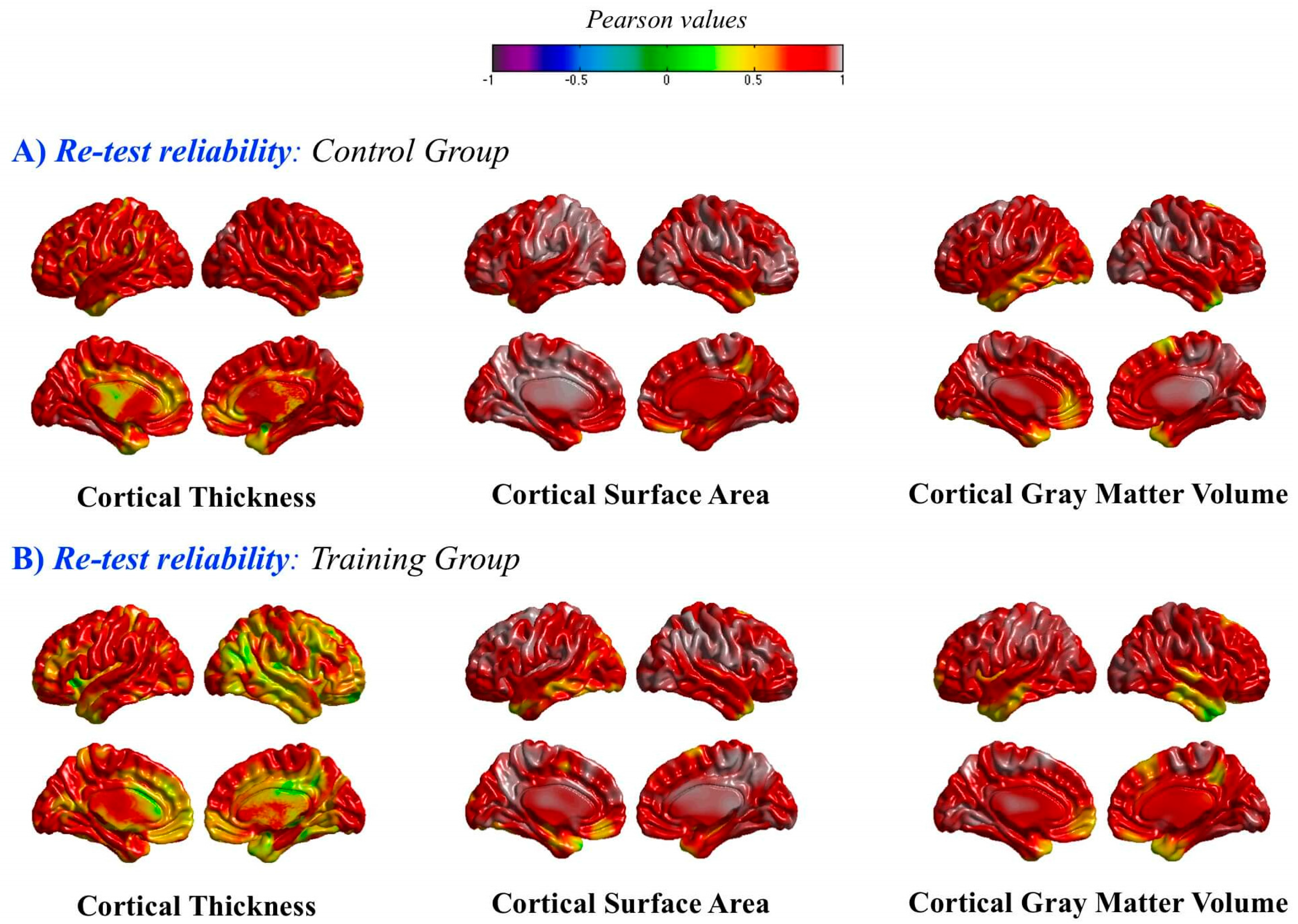
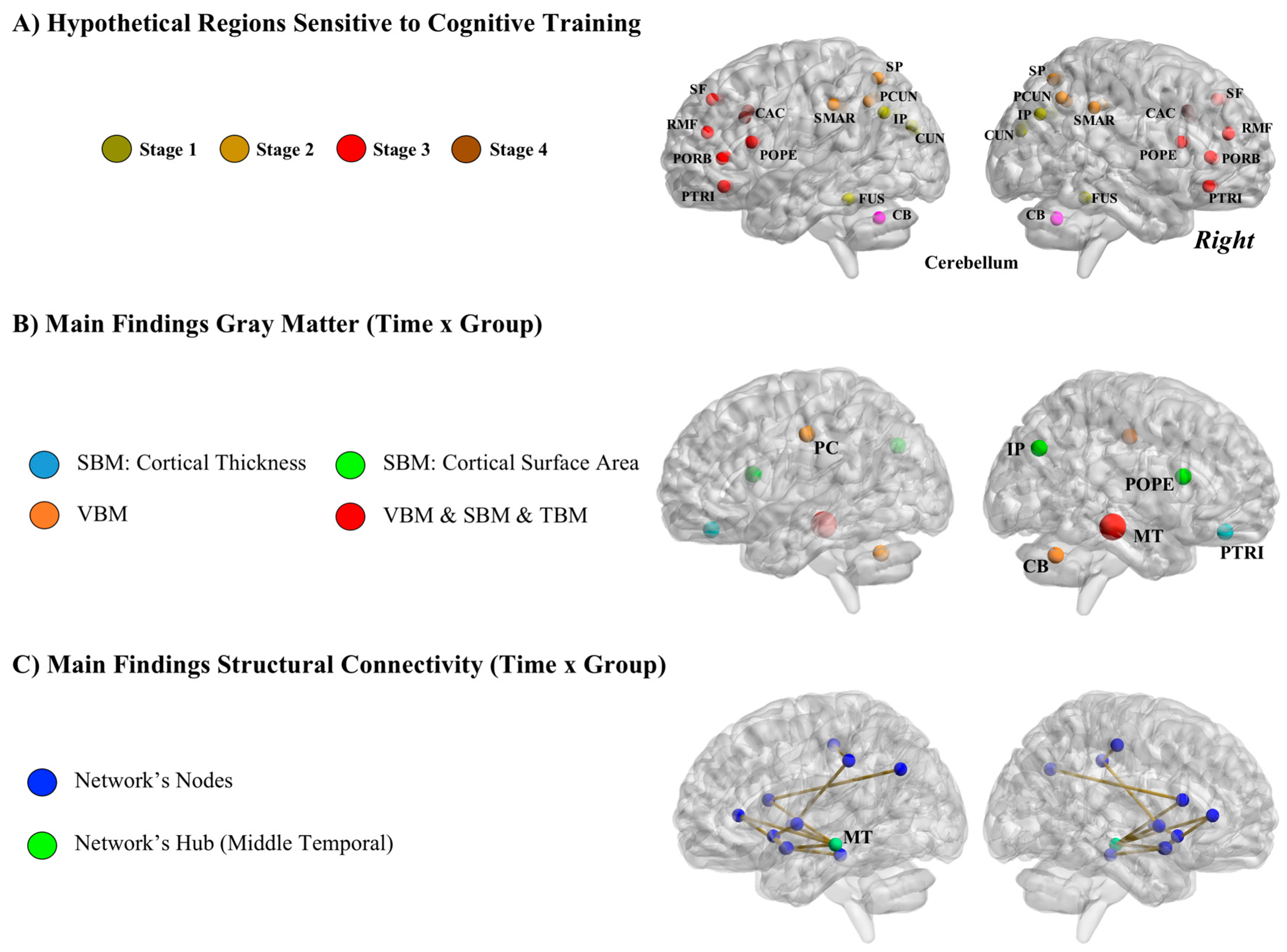
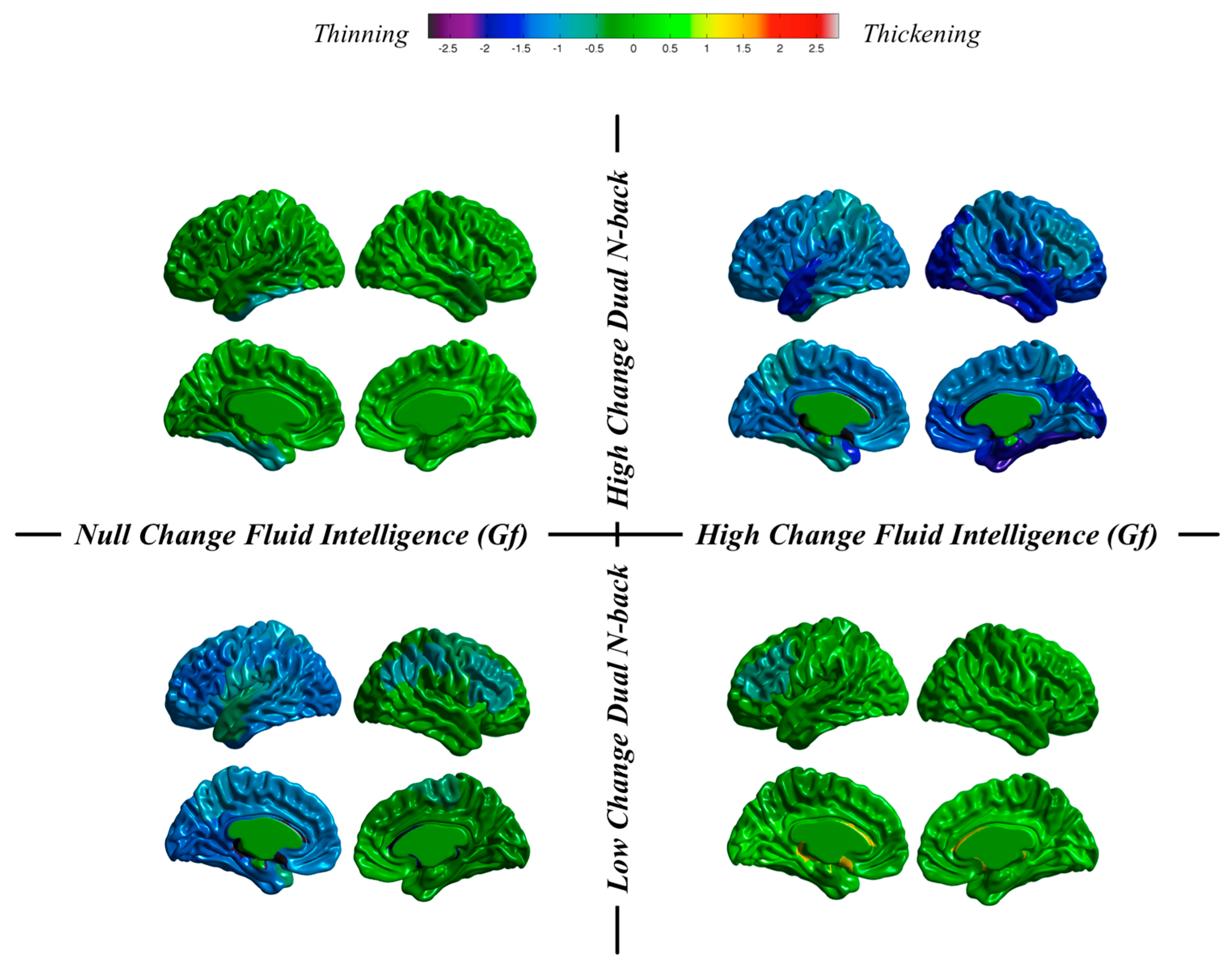
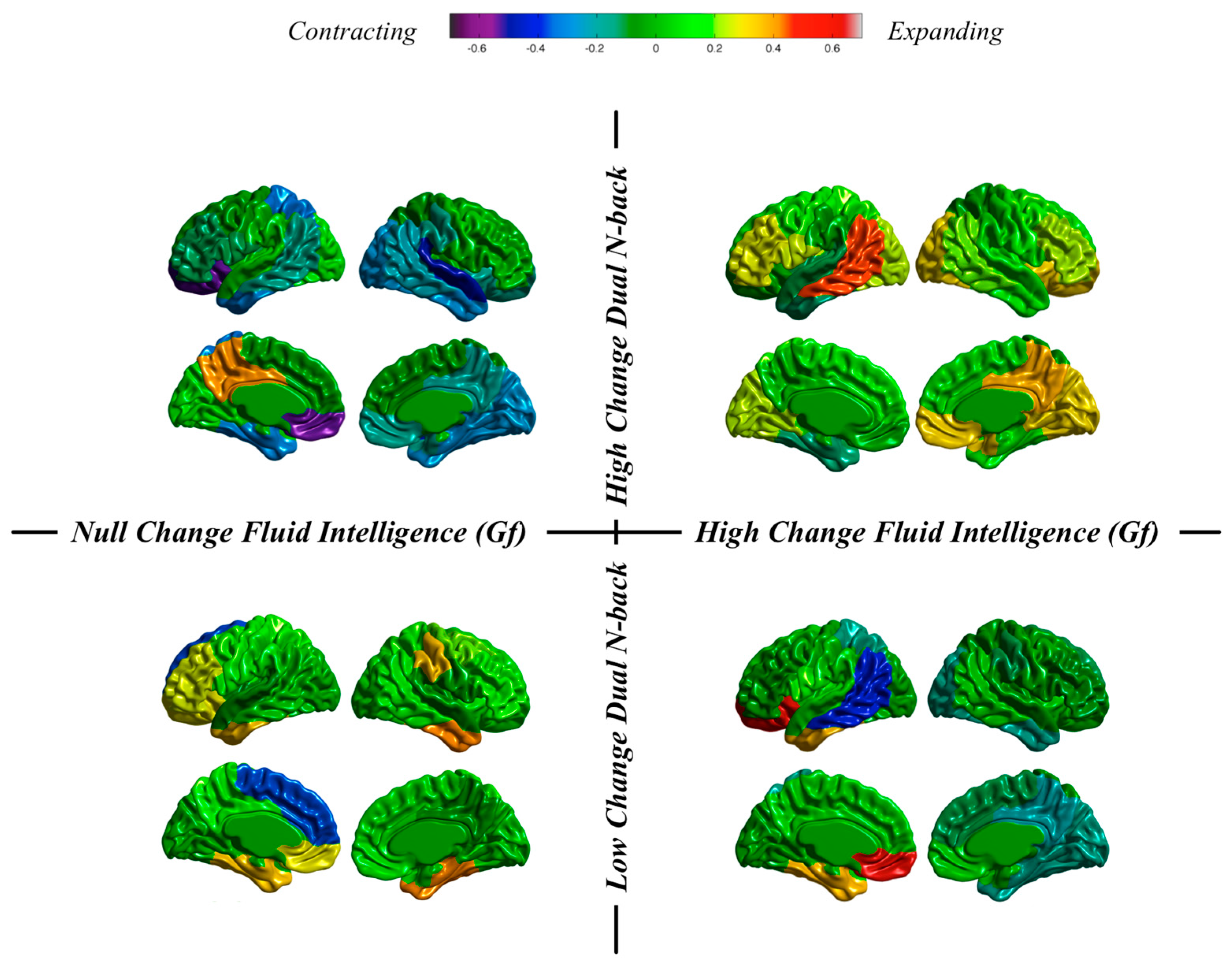
| Intelligence Measures | Cronbach’s Alpha | Spearman–Brown Correction |
|---|---|---|
| Gf-RAPM | 0.630 | 0.773 |
| Gf-DAT-AR | 0.675 | 0.806 |
| Gf-PMA-R | 0.765 | 0.867 |
| Gc-DAT-VR | 0.627 | 0.771 |
| Gc-DAT-NR | 0.675 | 0.808 |
| Gc-PMA-V | 0.835 | 0.910 |
© 2018 by the authors. Licensee MDPI, Basel, Switzerland. This article is an open access article distributed under the terms and conditions of the Creative Commons Attribution (CC BY) license (http://creativecommons.org/licenses/by/4.0/).
Share and Cite
Colom, R.; Román, F.J. Enhancing Intelligence: From the Group to the Individual. J. Intell. 2018, 6, 11. https://doi.org/10.3390/jintelligence6010011
Colom R, Román FJ. Enhancing Intelligence: From the Group to the Individual. Journal of Intelligence. 2018; 6(1):11. https://doi.org/10.3390/jintelligence6010011
Chicago/Turabian StyleColom, Roberto, and Francisco J. Román. 2018. "Enhancing Intelligence: From the Group to the Individual" Journal of Intelligence 6, no. 1: 11. https://doi.org/10.3390/jintelligence6010011






